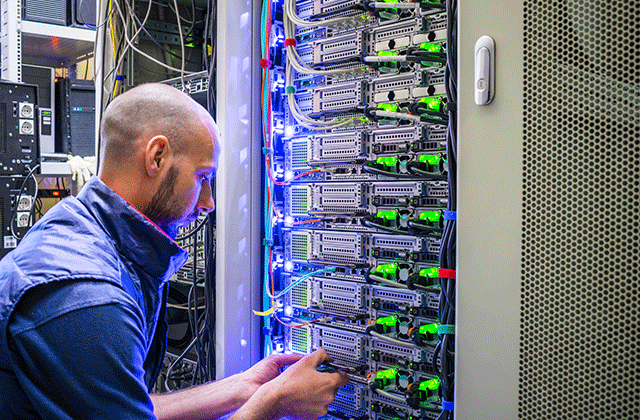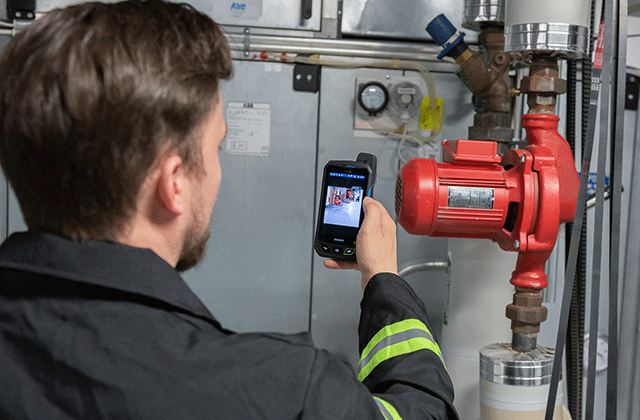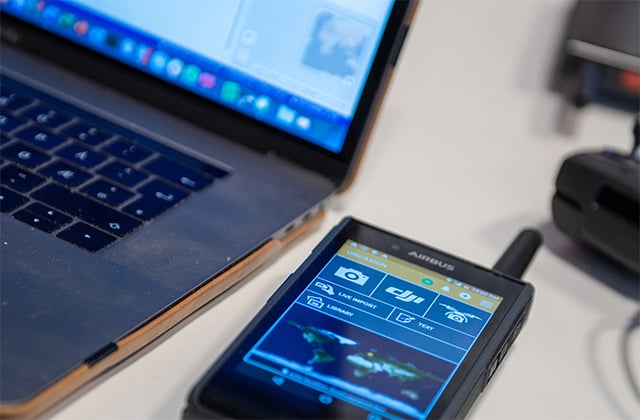Is your organization making the move to Industry 4.0? Would you like to improve processes without big, upfront investments? And of course, with minimum downtime?
If so, this may come as a surprise – advanced push-to-talk services can be integrated into your IT systems. And they can help improve your business. These 9 super useful tips tell you how.
A recent webinar from Airbus experts revealed 9 super useful tips that can improve your business with advanced PTT services:
- Choose a solution that integrates easily with your IT systems
- Put your data centers to work for your comms too
- Enable remote working
- Remember that accessories are important
- Avoid the risk of downtime when renewing your comms
- Future-proof yourself by choosing a system that can be developed
- Include your systems in your work teams
- Don’t think integration has to be complicated
- Choose PTT services that can be part of your mobility management
Watch the full webinar here:
Watch now: 9 simple tips how smart PTT services can better support your business
These 9 tips explain how advanced PTT services could support your business – with no upfront investment, and no risk of downtime.
Tip 1: Choose a solution that integrates easily with your IT systems
Manufacturing, airports, mining and transport companies are fast moving into the digital era. They use computer power and adopt cloud-based services. Enterprises want to improve, automate and digitize their operations.
They have been trading for a long time and built robust and resilient data centers. Their communication solutions are usually based on radios. They run on separate systems, not on IT infrastructure.
Data centers are of course involved in the first steps in digitalization. But the separate radio communication systems can be overlooked, and enterprises may also want to use their radios as long as possible. Yet, digitalization is not complete if communication solutions are out of date.

Digitalization, automation and better processes mean that fewer people can achieve more. Human intervention may only be necessary when there is a problem. Advanced PTT communication services should be part of this equation.
Two big worries are related to digital transformation - the size of the upfront investment and the risk of unexpected downtime. Both these worries can disappear with the right communication solution that runs on the IT systems.
The right solution can be Tactilon Agnet, for example. Because it uses an OPEX model, an enterprise can adopt advanced PTT services without a big upfront investment.
There is also no risk of downtime. Because Tactilon Agnet works well with legacy radio systems, the enterprise can use its existing communication system as long as necessary.
Tip 2: Put your data centers to work for your comms too
Many enterprises are looking for higher automation and data exchange at machinery level for production purposes. This is why they may have built or are planning to build data centers of their own.
The good news is that data centers can be used for more than that.
If you’re already building robust IT networks for production purposes, why not take advantage of them in your communications too? You will no longer need a separate communication system, and you will save money.
Tip 3: Enable remote working
The Covid-19 pandemic has forced many professionals to work remotely. They could use advanced PTT services for communication and for video discussions. A secure PTT solution keeps information safe.
Let’s take an example: someone on site needs support from a specialist engineer. The engineer would usually be on call on site, but she could just as well provide support over a video call. The secure PTT solution would keep everything confidential. A further benefit is a faster response time before the repair or support starts.
A team on site could provide a live feed from their helmet cameras or a body camera, and the team leader could supervise them remotely.

Another example would be areas that are closed for anyone not wearing protective gear. The staff inside could easily contact colleagues outside and ask for advice or share a video or photo.
With advanced PTT services, all this can happen within the company’s own secure IT environment. This means that it is possible to exchange confidential information.
The only investment needed is the monthly fee for the PTT service.
Tip 4: Remember that accessories are important
Working teams stay up to date thanks to group communication. That is why they need their device for PTT services throughout their entire shift. And that is why the device must be easy to carry and easy to use. The right accessories help tailor the device so the PTT services are comfortable to use.
Users have a wide choice of accessories and must make wise choices. Their first consideration should be how the accessory performs in the users’ working environment. Another consideration is appropriate certification.

For example, working in hazardous environments means that the accessory must be ATEX certified. ATEX certification is proof that the accessory is suitable for use at facilities such as oil and gas platforms, petrochemical facilities, steel plants, refineries, and harbors. Choosing accessories carelessly can lead to dangerous situations.
Tip 5: Avoid the risk of downtime when renewing your comms
Across industries, downtime is usually the result of a malfunction, and often very expensive. But downtime could also occur when installing or replacing the company’s communication system. In fact, any sudden switch from one solution to another is risky. This is why gradual adoption is the best choice when bringing a modern, advanced PTT service into use.
Don’t switch overnight. Take the new system into use while you’re still using the old one. Choose a PTT solution that can connect to the old. Check that groups and teams can include users from both systems.
When you use both systems in parallel, your employees can learn the new system gradually. You may want to start with a piloting phase. Eventually, people are used to the new system and everyone can switch over to using it. You can be certain that the new system works before you shut down the old system. This is the way to avoid risk of downtime.

More examples related to this tip can be seen on our webinar recording: Watch it now
Tip 6: Future-proof yourself by choosing a system that can be developed
Make sure you choose a scalable communication system. This will ensure that you can extend it and develop it by introducing new functions and third-party apps.
For the new functions and apps, you’ll also need a “pool of developers” such as the SmarTWISP application and accessory developers’ ecosystem. Your developers will need a way to integrate or add on the functions and apps to your system. They also need good documentation and example code. And if they run into any problems, they need quick access to help.

United Biometrics is a SmarTWISP member and a great example of a smaller hi-tech company that has successfully developed and integrated its Dual Authenticator application into the Tactilon Agnet solution from Airbus. Integration took only a short time from both Airbus and United Biometrics.
Learn more – watch this video: Christopher Richard, co-founder of United Biometrics shares his experience on integrating the company’s application into Tactilon Agnet. (His part starts at 15:07 on the video.)
Handpicked related content
Are consumer apps suitable for use as such on a professional duty device? How do consumer apps differ from professional apps? This blog post explores the topic: Professional apps vs. mainstream apps – what is the difference?
Tip 7: Include your systems in your work teams
Most organizations have a wealth of valuable information in their IT systems, and they could take advantage of it more easily if it met three requirements:
- In the right format
- Available at the right time
- Accessible to the right people.
One clever solution to this challenge would be to connect the valuable information directly into the group communications. In other words, the source of information would be “one of the team members”.
Unbelievable? Perhaps, but when a communication system provides proper Application Programming Interfaces (APIs), other systems can, indeed, be included in your team communications.
The result: you can connect valuable information into your group conversations.

Let’s take an example of a field engineer doing repair work. She takes a picture of the broken equipment. Then she would send the photo to a group chat where a bot (which is included as a team member) will analyze the photo.
Then, your connected IT systems could automatically check the data on spare parts and get back to the field engineer with helpful information. For example, the expected delivery time for the spare part.
There are some really fascinating ways to leverage your existing information system with the right kind of advanced PTT services.
Tip 8: Don’t think integration has to be complicated
Many organizations already use broadband-enabled devices for less critical purposes. And many people in these organizations still use radios for critical group communications.
The new 5G capabilities make it possible for professionals to adopt advanced PTT services for broadband push-to-talk, multimedia messaging, and push-to-video features. And a proper solution will also be able to interconnect both smartphone- and radio-carrying users.
Many organizations may believe that it is complicated to integrate broadband PTT services into the current radio system. But it doesn’t have to be that way. Today’s standard IP based networks can be quick and easy to integrate. It can take only a few weeks, and in the future, maybe only a few days.
And when the integration is complete, your users need to do nothing more than download the app into their smart devices.
Tip 9: Choose PTT services that can be part of your mobility management
Your organization’s plans include all types of sensors, devices and applications, so you will need a system that can manage all of them. The devices will need software and security updates, and you need to control their security. Managing many different devices, each with their own systems, would be a nightmare.
A suitably advanced PTT service can help you with this. A solution purchased as Software as a Service (SaaS) can include devices management in the same package.

What if you don’t want to adopt PTT services using the SaaS model? You still need to solve the issue of management, and Enterprise Mobility Management (EMM) solutions are a likely option. EMM gives you a view of all your the devices, just as if you had every one of them on your desk. You can see which software version they have, how much data they’ve used, and their battery levels, for example.
If you have EMM in use, your PTT services have to be able to connect to it.
And your management platform should be scalable and adaptable because there will always be new devices and technologies. Right now, the Internet of Things (IoT) is a hot topic. Your EMM must be ready to manage IoT sensors for sure.
The EMM platform must be able to handle the integration of new technologies without major changes to the system.
To summarize –
These were 9 super useful tips to improve your business with smart PTT services. Here’s a bonus for you: strong PTT services can save you money too. Download this eBook to learn how!
Download now: Five ways that strong PTT services can save you money





